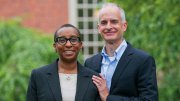Since the 1950s, the United States has led the world in science and technology, training an unrivaled pool of physicists, engineers, biologists, and chemists. Graduates from American universities have given the nation’s industries an edge in the race for technological innovation and helped ensure U.S. dominance in the global economy.
But the country’s leadership edge in science and technology is shrinking, according to a recent report by Ascherman professor of economics Richard B. Freeman, director of the Labor Studies Program at the National Bureau of Economic Research. Freeman spent the past three years investigating how a weak domestic job market in science and engineering, combined with the globalization of high-tech work, is affecting America’s supply of scientists and engineers and, by extension, the U.S. economy. He documents a dramatic shift in the distribution of scientific capital — including specialists, skilled workers, and research facilities — away from America’s shores toward newer high-tech centers in Europe and, more significantly, Asia.
Freeman believes this trend could soon threaten American technological competitiveness, especially as large developing countries like China and India harness their growing scientific and engineering expertise to their enormous, low-wage labor forces. The outsourcing of technical jobs, he warns, foreshadows the displacements American workers will likely face in coming years.
The source of America’s vulnerability, Freeman argues, lies in numbers. In 1970 more than half of the world’s science and engineering doctorates came from American universities, but now other countries have caught up. In 2001 the European Union (EU) granted 40 percent more science and engineering Ph.D.s than the United States, and by 2010 will produce nearly twice as many. China’s gains are even more striking. In 1975 the number of Chinese doctorates was negligible; but by 2003, the country had graduated 13,000 Ph.D.s — 70 percent of them in science and engineering. China is expected to surpass the United States in numbers of science and engineering doctorates by 2010. At the college level, statistics show a waning interest among U.S. students in science-related careers; in 2000, only 17 percent of all bachelor degrees in the United States were in natural sciences and engineering, compared to a world average of 27 percent and a Chinese average of 52 percent.
Freeman found that the uninviting job market for U.S. scientists and engineers has contributed to the nation’s falling share of high-tech manpower. In today’s economy, science and engineering students can expect lower incomes and less job security than their peers in other highly competitive fields like law and medicine. Ph.D.s in the sciences must undergo years of schooling and post-doc training, with little access to research grants, before they become eligible for full-time salaried positions. Moreover, the demographics of the academic job market have lowered the odds that new doctoral graduates will land faculty posts, even as older scientists retire.
These disincentives have left U.S. firms increasingly reliant on international students and immigrant degree holders (who have had fewer high-paying options at home) to fill science and engineering jobs. In 2000, foreign-born graduates made up more than half of the doctoral-level scientists and engineers in the United States younger than 45, and 60 percent of post-docs.
The inflow of international workers won’t be enough to offset the burgeoning numbers of science and engineering graduates in other nations. “There are one billion people in India and 1.3 billion Chinese,” Freeman points out, “and only a sliver of these populations is educated. But, combined, these two modern middle classes approximate the size of an entire advanced country like Japan — and attached to these middle classes is a huge labor source of peasants.” As China and India continue to expand their high-tech work forces and improve their infrastructures, they will no longer have to rely on technological imports from the United States, but will have the capacity to design and produce cutting-edge goods and services themselves, at significantly lower cost than their Western competitors. Freeman terms this process “human resource leapfrogging” and believes it will alter America’s global trade position, creating difficult economic adjustments at home.
Yet there’s clearly a positive side to the scientific advance of poorer countries. “With all of these scientists, engineers, and entrepreneurs in the world today,” Freeman says, “the potential for progress has increased incredibly. You have so many more people around the world who could work on a given problem, like reducing the use of fossil fuels.” He believes the United States needs to invest more resources in building a future generation of scientists and engineers — for example, by making more and larger National Science Foundation grants to graduate students. Strengthening ties to foreign universities could also help. The alternative is to be left behind. “If you don’t pour more money in,” Freeman warns, “everything you do will just be a Band-Aid.”
~Ashley Pettus
Richard Freeman e-mail address: freeman@nber.org





